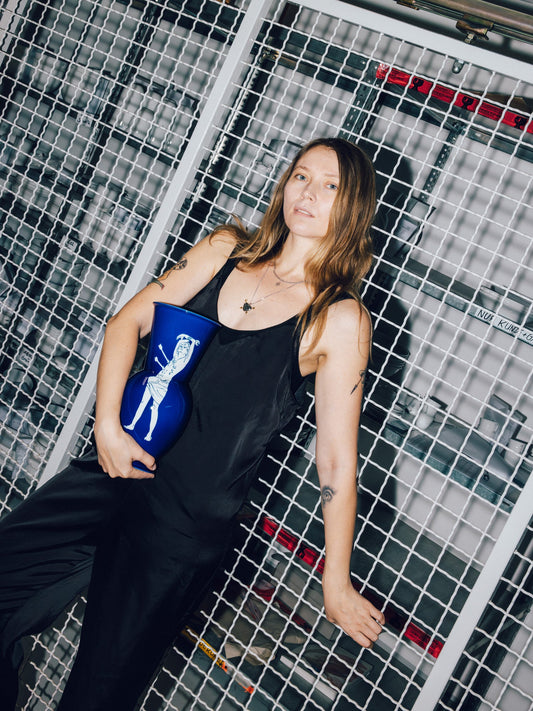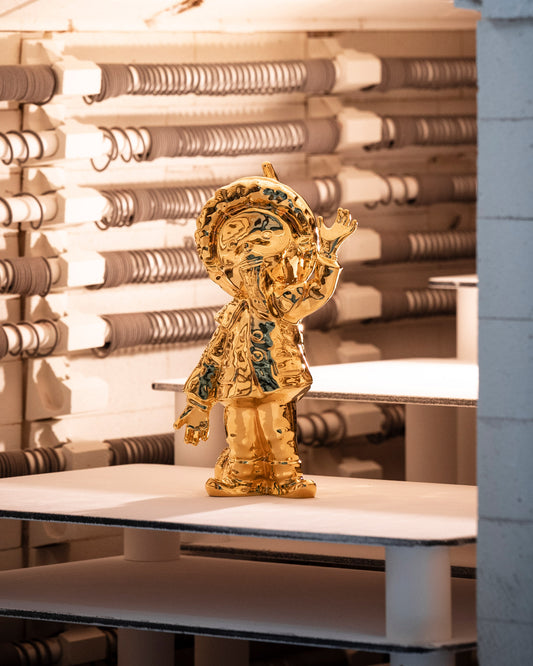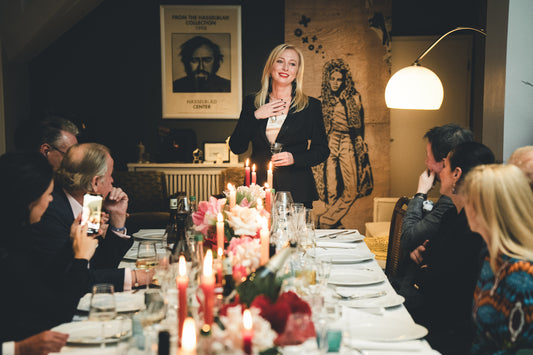Julia Beliaeva combines digital art and traditional craftsmanship
With the help of digitally created figures, Ukrainian artist Julia Beliaeva transfers motifs from classical mythology and Ukrainian folk tales to the Bauhaus vase HALLE by Marguerite Friedlander-Wildenhain at KPM Berlin Meistermalerei. In this interview, she reveals all about the process and the interplay between modern technologies and traditional porcelain painting...
What do you personally associate with porcelain?
Collecting porcelain was a matter of course for many people in my home country, Ukraine. Even in my childhood, it was an everyday companion and became an integral part of my memories. Over time, especially during my travels, I realized that porcelain plays a similar role in other cultures.
For a long time, porcelain was a symbol of home and familiarity for me. But in the course of my life, I came across more ornate, more elaborately crafted pieces and began to see porcelain as a luxury item.
As an artist, I question this image. I break through the idea of porcelain as a symbol of security. Instead, I confront the viewer with irritation and unease.
What is the significance and tradition of porcelain in Ukraine?
This is a rather sad story. At the end of the 1990s, most of the porcelain factories in Ukraine had to close their doors. Only the porcelain factory in Kyiv remained, albeit in a greatly reduced form. Today I work closely with this very factory.
Incidentally, the sculpture "Ballerina Lenochka" by the well-known Ukrainian porcelain artist Oksana Zhnikrup was later reinterpreted by Jeff Koons: Porcelain Pop Art by Oksana Zhnikrup
The artist Julia Beliaeva at the Königliche Porzellan-Manufaktur Berlin.
Were you able to learn something new about porcelain at the KPM Berlin Master Painters?
As part of my residency in Master Painting, I have been working intensively with overglaze painting for the first time, having previously worked exclusively with the underglaze technique. Overglaze painting is a very exciting process and I enjoy it much more than the underglaze technique. It was particularly exciting to learn previously unknown tricks and to familiarize myself with the airbrush technique thanks to the support of the experienced master painters in the manufactory.
You have chosen the Bauhaus vase HALLE by Marguerite Friedlander-Wildenhain as the basis for your collection. What significance does the Bauhaus have for your art?
I have always been impressed by how the Bauhaus combines constructivism and aesthetics. The design of the Halle is so well thought out in terms of its interaction with water and flowers that I still don't know of any vase with a better ergonomic design. I also like how the porcelain of the Bauhaus period turned its back on pure luxury. Instead, the focus was on functionality and practical use, entirely in the spirit of people and their everyday needs.
You deal with new technologies in your artistic work. What was it like for you to dedicate yourself to traditional craftsmanship in your collaboration with KPM Berlin?
I love challenges and this was one of them. In Kyiv, I don't have the opportunity to paint vases or tiles, as the factory there specializes exclusively in sculptures. The work was intense and the time frame tight, a combination that made the process particularly appealing to me.
You used Prussian blue for your collection and called it "Feel Blue". What is behind this?
For me, blue is a cosmic color, the color of transcendence. Humanity has lived through many crises in the course of history. Crises like the current war in my home country, Ukraine, which has affected my country and me greatly. In times like these, it is of existential importance to maintain your own mental stability.
For me, this particular shade of blue symbolizes inner stability and depth. I practice transcendental meditation and sometimes, when I close my eyes, I see exactly this color.
You have painted the vases with figures from classical mythology and Ukrainian folk tales. What stories do they tell?
These vases are a continuation of my first solo exhibition at the König Galerie. I have depicted all my code sculptures on them, which symbolize the reality in my home country.
The series is about injustice, anger, sacrifice and fear. It takes up familiar motifs from myths and folk tales and addresses the horrors of everyday life in Ukraine today.
I tell uncomfortable truths in the most pleasant way possible. The subtle restraint of porcelain sculptures exerts a special attraction: These objects do not force the truth on you, but gently draw you into it. They invite you to listen - even when you might not want to.


